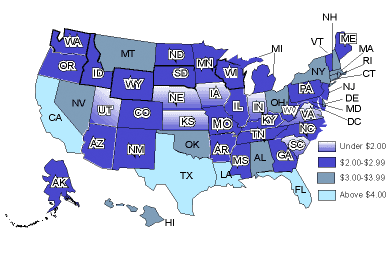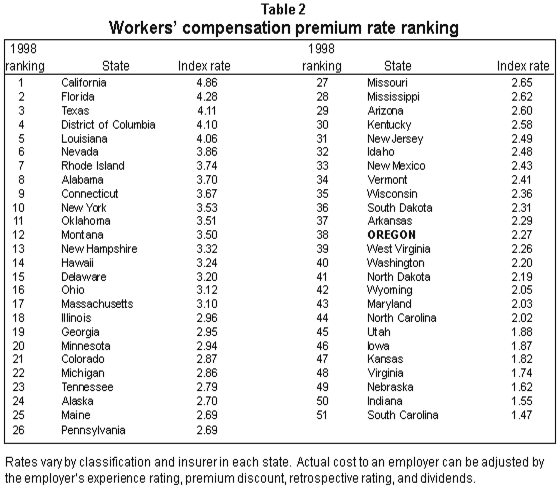
Oregon employers in the voluntary market pay, on
average, the 38th highest workers’ compensation premium
rates in the nation.
Oregon’s premium rate index is $2.27 per $100 of payroll. National premium rate indices range from a low of $1.47 in South Carolina to a high of $4.86 in California. Five jurisdictions have index rates above $4.00; 12 are in the $3.00-$3.99 range; 27 have indices between $2.00 and $2.99; and seven have index rates under $2.00. Indices are based on data from 51 jurisdictions, for rates in effect as of January 1, 1998.

Classification codes from the National Council on Compensation
Insurance (NCCI) were used in this study. Of the approximately
452 active classes in Oregon, 50 were selected based on relative
importance as measured by share of losses in Oregon.  To control for differences in industry distributions,
each state’s rates were weighted by 1992-1994 Oregon payroll
to obtain an average manual rate for that state. Listed in Table
1 are Oregon’s rankings in the top 10 of the 50 classifications
used.
To control for differences in industry distributions,
each state’s rates were weighted by 1992-1994 Oregon payroll
to obtain an average manual rate for that state. Listed in Table
1 are Oregon’s rankings in the top 10 of the 50 classifications
used.
Table 2 contains the premium rate ranking for all 51 jurisdictions.

Note: California’s loss cost multiplier for 1998 is more than twice the reported 1996 multiplier. The difference does not reflect an actual increase however, but the effect of using a premium weighted average multiplier, consistent with the methodology of the study, as opposed to a straight average in 1996. The premium weighted lost cost multiplier includes California’s state fund which serves 20 percent of the market, both as a voluntary insurer and as the insurer of last resort, and has a loss cost multiplier of 1.743. It is not possible to separate out only the state fund’s voluntary business. The state fund insures small employers with premiums under $1,000 per year. Those employers pay rates based on the 1.743 rate, but larger employers are granted credits which reduce the effective multiplier. In fact, for the total market in 1998, California’s Actual Price Level Factor, the ratio of final insurer aggregate rates to pure premium rates, was .96. For consistency, this study does not include any credits granted to employers on an individual basis, and thus can reflect only the premium weighted average loss cost multiplier of 1.424.
![]()
Employers can reduce their workers' compensation rates through accident prevention, safety training and by helping injured workers return to work.
| DCBS Public Home Page | IMD Home Page | Site Search Engine |
If you have questions about the information
contained in this document please contact by e-mail or phone:
Heather Ferrin-Myers,
Research Analyst, Research & Analysis Section, Information
Management Division (503) 947-7338
This document was originally published in
February 1999. Printed form: 440-2082 (02/99/IMD)
Document URL: http://www.cbs.state.or.us/external/imd/rasums/2082/8_2082.html
In compliance with the Americans with Disabilities Act (ADA),
this publication is available in alternative formats by calling
(503) 378-4100 (V/TTY). The information in IMD publications is
in the public domain and may be reprinted without permission.